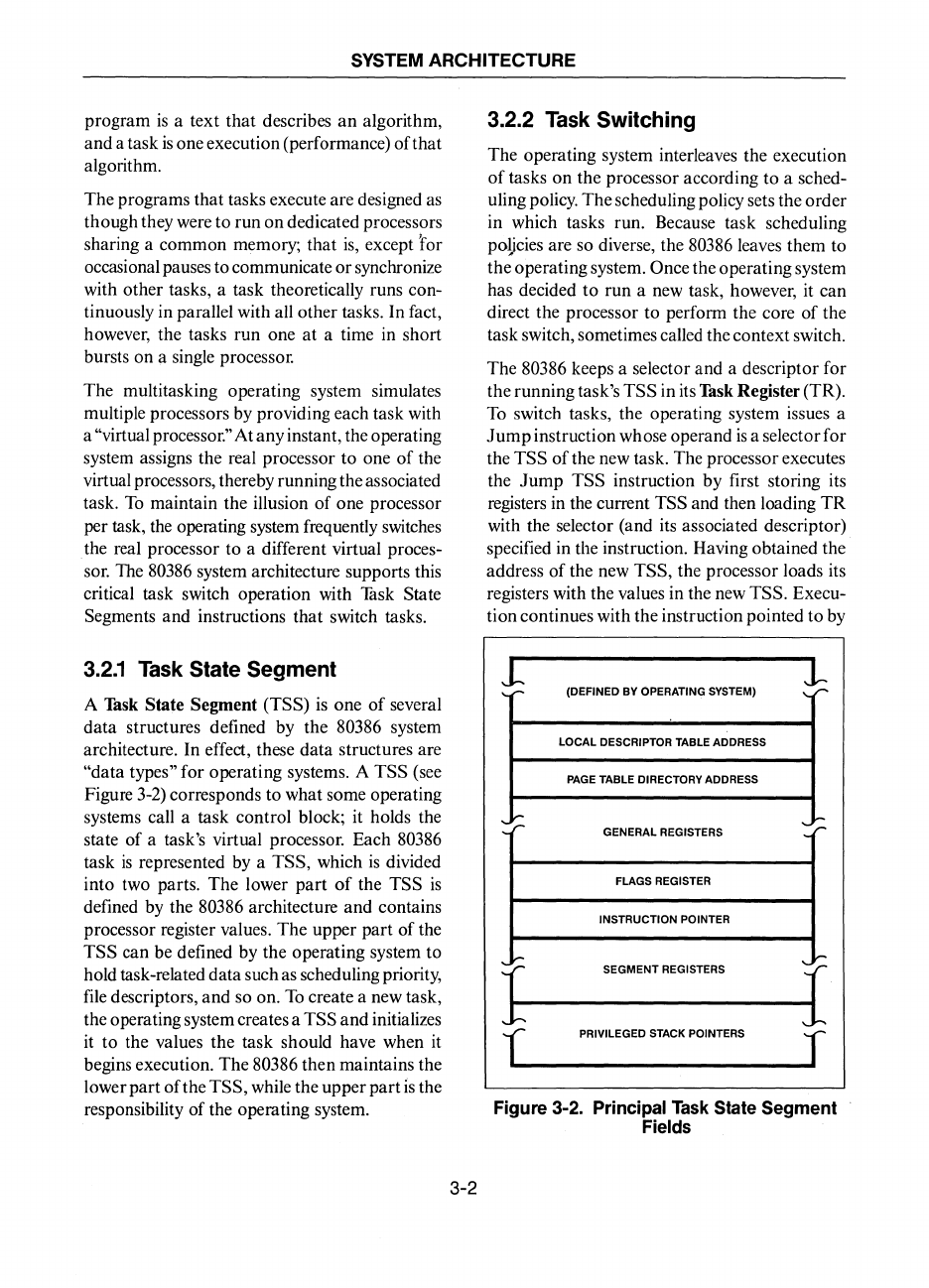
SYSTEM
ARCHITECTURE
program
is
a text that describes
an
algorithm,
and a task
is
one execution (performance)
ofthat
algorithm.
The programs that tasks execute are designed as
though they were to run
on
dedicated processors
sharing a common memory; that
is,
except
ror
occasional pauses to communicate or synchronize
with other tasks, a task theoretically runs con-
tinuously in parallel with all other tasks. In fact,
however, the tasks run one at a time in short
bursts on a single processor.
The multitasking operating system simulates
mUltiple processors by providing each task with
a
"virtual processor." At any instant, the operating
system assigns the real processor to one of the
virtual processors, thereby running the associated
task.
To
maintain the illusion of one processor
per task, the operating system frequently switches
the
real processor to a different virtual proces-
sor. The
80386 system architecture supports this
critical task switch operation with
Task
State
Segments and instructions that switch tasks.
3.2.1
Task State Segment
A Task State Segment (TSS)
is
one
of
several
data structures defined by the
80386 system
architecture. In effect, these data structures are
"data types" for operating systems. A TSS (see
Figure
3-2)
corresponds to what some operating
systems call a task control block; it holds the
state
of
a task's virtual processor. Each 80386
task
is
represented by a TSS, which
is
divided
into two parts. The lower
part
of
the TSS
is
defined by the 80386 architecture and contains
processor register values. The upper part of the
TSS can be defined by the operating system to
hold task-related data such
as
scheduling priority,
file descriptors, and so on.
To
create a new task,
the operating system creates a
TSS and initializes
it to the values the task should have when it
begins execution. The
80386 then maintains the
lower
part
of
the TSS, while the upper
part
is
the
responsibility of the operating system.
3-2
3.2.2 Task Switching
The operating system interleaves the execution
of
tasks on the processor according to a sched-
uling policy.
The
scheduling policy sets the order
in which tasks run. Because task scheduling
poljcies are so diverse, the
80386 leaves them to
the operating system.
Once the operating system
has decided
to
run a new task, however, it can
direct the processor to perform the core of the
task switch, sometimes called the context switch.
The
80386 keeps a selector and a descriptor for
the running task's
TSS in its Task Register (TR).
To
switch tasks, the operating system issues a
Jump
instruction whose operand
is
a selector for
the
TSS
of
the new task. The processor executes
the
Jump
TSS instruction
by
first storing its
registers in the current
TSS and then loading
TR
with the selector (and its associated descriptor)
specified in the instruction. Having obtained the
address of the new
TSS, the processor loads its
registers with the values in the new
TSS. Execu-
tion continues with the instruction pointed to by
1
l-
..
--
(DEFINED
BY
OPERATING SYSTEM) ,roo
LOCAL
DESCRIPTOR TABLE ADDRESS
PAGE TABLE
DIRECTORY ADDRESS
..
~
GENERAL REGISTERS
~
~
FLAGS REGISTER
INSTRUCTION
POINTER
..
'"
....
--
SEGMENT
REGISTERS
I
PRIVILEGED STACK POINTERS
r
Figure 3-2. Principal
Task
State Segment
Fields


















